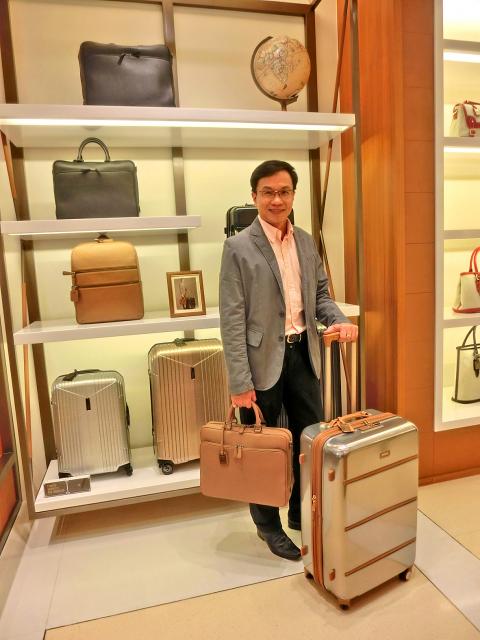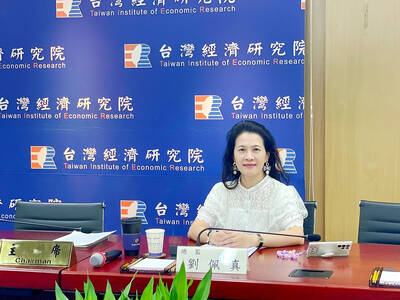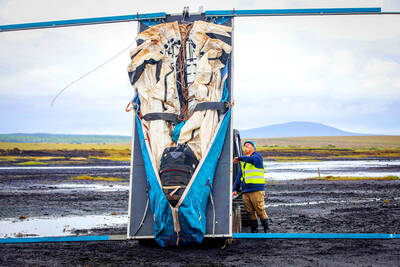Vivian Lin (林易萱), a 30-year-old local office worker, has traveled abroad three times over the past three years.
During that three-year period, Lin bought two suitcases with different sizes and styles.
“Other than the functionality, I found brand familiarity and design to be the two major deciding factors when choosing and purchasing a suitcase,” Lin told the Taipei Times in a telephone interview.

Photo: Amy Su, Taipei Times
Compared with five years ago, an increasing number of Taiwanese in their 30s see fashion and style as important elements when choosing suitcases.
To capitalize on this trend, Samsonite Pacific Ltd (美商新秀麗太平洋), a subsidiary of the US-based Samsonite International SA, is introducing a new premium luggage and leather goods brand, Hartmann, to Taiwan in the second half of this year.
The Hartmann brand, founded in 1877, is recognized as a mark of luxury by consumers in the US, leading Samsonite International, the world’s largest travel luggage company to acquire it in 2012.
Samsonite Pacific opened its first Hartmann outlet in Taiwan in August at Mega City (板橋大遠百), a shopping mall owned by the Far Eastern Group (遠東集團) in New Taipei City’s Banciao District (板橋).
The company further plans to launch two new outlets under the Hartmann brand by the end of this year, at Top City (台中大遠百) in Greater Taichung and T.S. Dream Mall (南紡夢時代購物中心) in Greater Tainan respectively, to expand the brand’s market coverage to central and southern Taiwan.
Eyeing a similar target audience as Rimowa — a German-based luxury luggage brand widely known in Taiwan — Samsonite Pacific is scheduled to raise its total Hartmann outlets in Taiwan to nearly 10 in three years, compared with a total of 14 Rimowa stores nationwide.
“We hope to build up Hartmann’s brand awareness among Taiwanese customers with medium to high-level consumption power in the preliminary stage of operations,” Samsonite Pacific general manager Nick Lin (林福平) told the Taipei Times in an interview earlier this month.
Lin said there are many Taiwanese consumers in their 30s or even younger with strong purchasing ability who are willing to spend more on a suitcase for a quality brand and unique style, as Taiwan became the third Asian market to welcome the Hartman brand, after Japan and China.
These medium to high-income consumers usually show steadier purchasing ability than other consumers, even amid sluggish economic sentiment, which made Lin confident in the Hartmann brand’s development in Taiwan.
However, the situation also reflected major uncertainty in the suitcase market as a whole, due to the close connection between luggage sales and the global economy.
Global economic weakness may drag down the sales momentum of travel luggage, as the number of business trips declines because of slowing economic activity and people have less money to travel abroad on vacation, Lin said.
That made Samsonite International accelerate its expansion into the bag industry over the past few years, either by raising the proportion of such products under its current brands, or merging and acquiring new brands.
“The bag industry, both in Taiwan and globally, has enjoyed higher and steadier demand than travel luggage,” Lin said. “We hope the company can have a place in the bag sector in the long-term future, while consolidating our strength in luggage industry as well.”
Taking the Hartmann brand as an example, non-travel products currently account for about half of its overall products, leading Samsonite International to reformulate the brand’s concept and product mix after acquiring it, Lin said.
As for the company’s main brand, Samsonite, the company gradually raised its proportion of non-travel products to about 30 percent, he added.
To boost its product diversification, Samsonite International has also acquired several brands since 2012, enabling it to expand its presence not only in the high-end luggage and leather goods market, but also into the outdoor lifestyle and the smartphone case businesses.
Samsonite International now owns eight brands, with products including luggage, business and computer bags, outdoor and casual bags, and travel accessories across various price bands to cover consumers from the middle to the top of the spending range.
In addition to Samsonite and Hartmann, the other six are: Samsonite Red, American Tourister, High Sierra, Lipault, Speck and Grogery.
In Taiwan — a market with great diversity — Lin said all of the company’s brands have their own potential in development, with the Samsonite brand having entered the nation’s market more than 20 years ago.
However, the company’s business in Taiwan suffered from poor brand positioning and sales channel confusion.
Because of this, Lin committed himself to channel reform and brand repositioning after joining the company’s management in August 2009, by setting up a straightforward channel strategy for the company’s brands.
The channels for the Hartmann, Samsonite and Samsonite Red brands are concentrated in department stores, with American Tourister — a young and fashionable travel brand with mid-level prices — to expand sales from department stores and hypermarkets to e-commerce channels, aiming to generate volume via trade-ups from local brands.
As for Samsonite’s two outdoor lifestyle brands with different price bands — Gregory and High Sierra — and smartphone case manufacturer Speck, Lin developed a strategy to license sales of these brands to an exclusive agent in Taiwan.
Internally, Lin improved the assignment of responsibility at Samsonite Pacific, while boosting the company’s profitability by reforming inventory and warehouse management, which has helped lower the company’s costs in the sector by 30 percent.
The moves sparked a nearly three-fold growth in sales last year from 2009, rebounding quickly from the global financial crisis in 2008 and further drawing its parent group’s attention to Taiwan’s strong market potential, which had previously been seen as relatively small.
The company plans to introduce newly acquired brand Lipault to Taiwan in the second half of next year, Lin said, as it aims to maintain its momentum in the nation via the youthful French luggage brand with functional and fashionable designs.

A proposed 100 percent tariff on chip imports announced by US President Donald Trump could shift more of Taiwan’s semiconductor production overseas, a Taiwan Institute of Economic Research (TIER) researcher said yesterday. Trump’s tariff policy will accelerate the global semiconductor industry’s pace to establish roots in the US, leading to higher supply chain costs and ultimately raising prices of consumer electronics and creating uncertainty for future market demand, Arisa Liu (劉佩真) at the institute’s Taiwan Industry Economics Database said in a telephone interview. Trump’s move signals his intention to "restore the glory of the US semiconductor industry," Liu noted, saying that

On Ireland’s blustery western seaboard, researchers are gleefully flying giant kites — not for fun, but in the hope of generating renewable electricity and sparking a “revolution” in wind energy. “We use a kite to capture the wind and a generator at the bottom of it that captures the power,” said Padraic Doherty of Kitepower, the Dutch firm behind the venture. At its test site in operation since September 2023 near the small town of Bangor Erris, the team transports the vast 60-square-meter kite from a hangar across the lunar-like bogland to a generator. The kite is then attached by a

Foxconn Technology Co (鴻準精密), a metal casing supplier owned by Hon Hai Precision Industry Co (鴻海精密), yesterday announced plans to invest US$1 billion in the US over the next decade as part of its business transformation strategy. The Apple Inc supplier said in a statement that its board approved the investment on Thursday, as part of a transformation strategy focused on precision mold development, smart manufacturing, robotics and advanced automation. The strategy would have a strong emphasis on artificial intelligence (AI), the company added. The company said it aims to build a flexible, intelligent production ecosystem to boost competitiveness and sustainability. Foxconn

Leading Taiwanese bicycle brands Giant Manufacturing Co (巨大機械) and Merida Industry Co (美利達工業) on Sunday said that they have adopted measures to mitigate the impact of the tariff policies of US President Donald Trump’s administration. The US announced at the beginning of this month that it would impose a 20 percent tariff on imported goods made in Taiwan, effective on Thursday last week. The tariff would be added to other pre-existing most-favored-nation duties and industry-specific trade remedy levy, which would bring the overall tariff on Taiwan-made bicycles to between 25.5 percent and 31 percent. However, Giant did not seem too perturbed by the